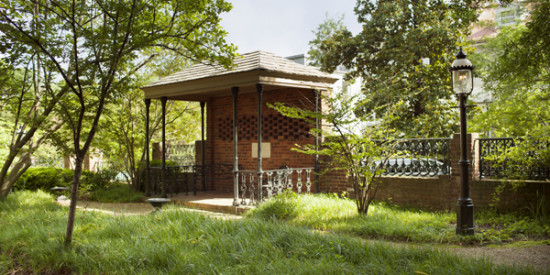Nestled just steps away from Historic St. John’s Church on Church Hill lies a community garden that looks and feels historic … but isn’t. St. John’s Mews occupies what would have been a carriage path that bisects a residential block bordered by East Broad and Grace streets in one direction and 23rd and 24th streets in the other.
This year’s Historic Garden Week tours, presented by Garden Club of Virginia, was to have included homes in Church Hill – and the Mews. The week has been canceled due to the novel coronavirus pandemic, but the painting that H.J. Holtz & Son did to freshen the space, which took place weeks ago, is still on display.
In 1956, the Historic Richmond Foundation (now Historic Richmond), launched a project to save historic Church Hill homes. During that effort, yardage was taken from the rear of the Broad Street properties on one block to allow for the creation of a community garden.
Seeking a formal and appropriate plan, Historic Richmond approached the Garden Club of Virginia for assistance in 1964, and landscape architect Ralph Griswold was hired. His design, inspired by Richmond’s Victorian ornamental cast-iron work and the conventions of 19th century gardens, included plantings as well as cast-iron used in a variety of ways: as railings, benches, planters, and a brick-and-iron pavilion, perfect for respite on a hot summer day.
“This was truly a reimagination of a garden that would have been appropriate to the location,” says Danielle Worthing Porter, HR’s director of preservation.
Maintenance of the Mews is managed by Historic Richmond, with regular pruning, trimming and occasional plant replacement, Porter says. A significant restoration was last undertaken in 2009. Some attention was needed in anticipation of this year’s garden week.
H.J. Holtz & Son had worked with Historic Richmond in the past, and won this job in a three-bid process.
“We were really impressed with the work [Holtz] did at Congregation Beth Ahabah,” Porter says, and says past experiences with the company have always been “professional and pleasant.”
“We definitely reach out for any project,” she adds.
This job included prepping and repainting four iron pots, the door and trim on a storage shed, and the soffit, trim, ceiling, and railings in the pavilion. The color, which may surprise visitors, is Black Forest Green, Porter says.
“Ironwork typically looks black over time, but it’s not really black,” she says. “This is slightly more green than people may remember.”
Porter says Historic Richmond trusts H.J. Holtz & Son to handle the myriad issues that come into play in the Mews.
“It’s about how you treat the building, how you prep the space, what type of paint is used, all of it,” Porter says. “There’s also a fine balance between how much you paint something. You want to protect it from rust, but you don’t want so much paint that you cover details.
“H.J. Holtz & Son really lives up to their reputation,” she adds.

